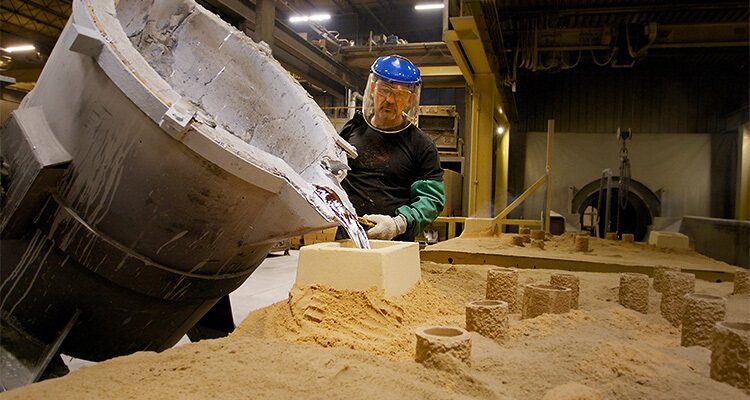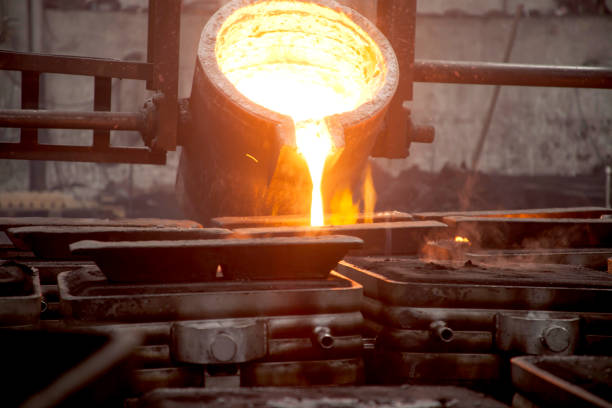Engineering Principles Behind Aluminum Castings and Their Remarkable Performance
Wiki Article

Comprehending the Process: How Aluminum Foundries Create High-Quality Products
Aluminum foundries play an important role in producing high-grade products through a precise process. It starts with melting raw aluminum, which eliminates impurities. Afterward, numerous molding strategies form the steel right into desired types. Precision throughout putting and solidification is crucial to satisfy specific requirements. The last stages include completing touches that boost sturdiness and appearance. As modern technology breakthroughs, these procedures are refined better. What advancements are shaping the future of aluminum foundries?The Melting Process: Changing Raw Aluminum
The melting procedure serves as a critical action in transforming raw aluminum right into functional items. Aluminum scrap or raw ingots are placed in a heater where they are subjected to high temperature levels, normally reaching around 660 levels Celsius. This extreme warm creates the aluminum to liquefy, permitting impurities to climb to the surface, where they can be skimmed off.Different melting techniques, such as induction melting or gas-fired melting, may be used depending upon the details demands of the shop. The choice of method can affect energy effectiveness and steel quality. Preserving specific temperature control is vital to assure uniform melting and to stay clear of oxidation that can endanger the material.
When thawed, the aluminum awaits additional handling, establishing the stage for subsequent operations that will certainly mold and mildew it into specific shapes and items. Aluminum Foundry. The quality of the melting procedure straight impacts the stability of the last aluminum things produced
Molding Methods: Forming the Future
After the aluminum has actually been thawed and pollutants eliminated, it is ready for shaping via various molding methods. Among one of the most prevalent methods is sand casting, where a mold and mildew is developed from sand and a binder. This method enables for elaborate designs and is economical for reduced to tool manufacturing runs. One more preferred method is pass away spreading, which entails requiring liquified aluminum right into a steel mold and mildew under high pressure. This method causes high accuracy and smooth surface areas, making it suitable for automation.
Permanent mold and mildew spreading is additionally utilized, using multiple-use molds that boost dimensional precision and surface coating. Each molding technique supplies special advantages, permitting foundries to tailor their procedures based upon item requirements and production quantity. By picking the suitable technique, aluminum foundries can guarantee premium quality and efficiency in their end products, solidifying their duty in various sectors.
Pouring and Solidification: The Art of Casting
Putting molten aluminum right into molds marks a crucial stage in the casting process, where accuracy and timing are necessary - Aluminum Foundry. The foundry team must carefully manage the temperature level of the aluminum to guarantee excellent fluidity, preventing flaws such as porosity or chilly shuts. As the metal is poured, it moves right into the complexities of the mold and mildew, filling every tooth cavity to develop the desired formSolidification starts right away as the liquified aluminum more info alters and cools down to a solid state. This phase is affected by a number of variables, consisting of the mold and mildew product, density, and ambient temperature. The cooling rate should be handled to prevent tension cracks or bending in the ended up item.
Once solidified, the aluminum takes on the precise dimensions and features of the mold and mildew, setting the stage for subsequent processing. This pouring and solidification process exemplifies the delicate balance of art and scientific research in aluminum casting, essential for creating high-quality items.
Finishing Touches: Making Sure Quality and Precision
Assuring quality and accuracy in aluminum items requires precise focus to detail throughout the completing procedure. This phase involves different techniques focused on improving the surface qualities and dimensional accuracy of the cast parts. Common methods include machining, surface therapy, and sprucing up. Machining remedies any type of dimensional inconsistencies and accomplishes the preferred tolerances, while surface area therapies, such as anodizing or powder layer, supply rust resistance and improve visual charm.Sprucing up eliminates surface imperfections, causing a smooth surface that meets rigorous specs. Quality control is paramount; each finished item undergoes strenuous assessment to identify any kind of problems. Advanced measuring devices, like coordinate determining equipments (CMM), are commonly used to assure conformity with style specs. Additionally, experienced professionals play a vital function, bringing experience and competence to determine concerns that devices might neglect. This detailed finishing procedure ultimately ensures that the aluminum products satisfy consumer assumptions for quality and efficiency.
Technologies in Aluminum Foundry Innovation
The search of high quality and accuracy in aluminum products has caused significant developments in factory modern technology. Innovations such as robot automation have streamlined procedures, enhancing effectiveness and lowering human mistake. These robots are now qualified of executing complicated jobs, consisting of accurate mold and mildew handling and product putting, which guarantees consistent product high quality.On top of that, the integration of computer numerical control (CNC) makers has actually changed machining procedures, permitting intricate designs and tighter tolerances. Advanced simulation software application promotes better procedure preparation by predicting potential issues and maximizing steel circulation. Additionally, the fostering of eco pleasant practices, such as reusing aluminum scrap and using low-emission furnaces, has improved sustainability in the sector.

Often Asked Questions
What Sorts Of Aluminum Alloys Are Commonly Made Use Of in Factories?
Commonly used aluminum alloys in foundries include 356, 319, and 413. These alloys are known for their exceptional casting residential properties, mechanical strength, and resistance to deterioration, making them suitable for a vast range of applications.Just How Do Foundries Ensure Ecological Sustainability in Their Processes?
Factories apply environmental sustainability by reusing aluminum scrap, optimizing power efficiency, minimizing emissions, making use of environment-friendly products, and sticking to regulative standards, consequently minimizing their eco-friendly footprint while preserving manufacturing high quality and effectiveness.What Safety Procedures Are Applied in Aluminum Foundries?
Aluminum foundries implement different precaution, including individual protective devices, ventilation systems, normal safety and security training, emergency response protocols, and equipment maintenance checks. These techniques intend to decrease hazards and guarantee the wellness of all employees entailed.Just How Do Factories Take Care Of Defects in Cast Products?
Foundries attend to issues in actors products by utilizing extensive inspection techniques, including visual checks and non-destructive testing. When problems are determined, they might revamp or ditch items, making sure adherence to high quality requirements and customer specs.What Is the Normal Preparation for Aluminum Spreading Projects?
The regular preparation for aluminum spreading projects ranges from a few weeks to numerous months. Aspects influencing this timeline consist of design complexity, production quantity, and the accessibility of products, which differ substantially across various foundries.Aluminum foundries play a crucial function in generating high-grade items with a precise procedure. Wisconsin Aluminum Foundry. The factory team must thoroughly manage the temperature of the aluminum to guarantee perfect fluidity, preventing flaws such as porosity or chilly shuts. The pursuit of top quality and accuracy in aluminum products has led to substantial advancements in shop technology. Typically made use of aluminum alloys in foundries include 356, 319, and 413. Aluminum foundries execute various safety steps, consisting of personal protective devices, ventilation systems, regular security training, emergency feedback protocols, and equipment upkeep checks
Report this wiki page